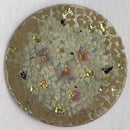Introduction: Gold Leaf a Live Edge Wooden Bowl
This project makes a handsome focal point for your holiday table, as well as a unique housewarming or host gift. The natural peaks and crags of the bark edge are beautifully highlighted with genuine 23kt gold leaf.
Step 1: What You'll Need
Live edge wooden bowl, unsealed
Soft square or round brush for applying gold size
Soft brush for tamping and brushing leaf
Sepp Gilding Workshop Red Primer
Sepp Gilding Workshop Oil-Based Leaf Adhesive (glue for leaf)
Sepp Gilding Workshop 23kt patent gold leaf – book of 25 leaves
Sepp Gilding Workshop Acrylic Clear Coat (solvent-based)
Optional - Liberon Pure Tung Oil for food-safe sealing of bowl interior, after gilding
Step 2: Apply Red Primer
After clearing your bark edge of any dust/debris and gluing any loose bits, you are ready to prime. This is a crucial step for two reasons: the primer seals the porous bark so that the gilding size doesn’t absorb into the wood; it also provides an extra hint of warmth to the gold leaf, since genuine gold leaf is thin enough that it is affected by background colors.
You can choose yellow or gray primer as well - yellow will blend with the gold, and gray will provide a cooler, darker contrast.
Step 3: Apply Oil-Based Quick Size (Leaf Adhesive)
Once the primer has dried, apply oil-based Leaf Adhesive (size) gently but thoroughly to fill in all the peaks and valleys. You’ll want to neatly cover all primed areas. Paint the top and inner edge first, then flip the bowl over onto a container and complete the outer edge. Leave the bowl to dry in this position: it will keep the size from dripping down onto the rest of the bowl as it comes to tack and keep dust away from the size keeping it pristine.
Step 4: Checking the Tack
Typically, the size will come to tack in about an hour, and gives you about an hour to gild, but this varies with temperature and humidity. Periodically check the size. When ready to gild, the size should feel dry but tacky. If you press your knuckle to the surface it should come away with no residue.
Step 5: GIld the Edge
Hold the gold leaf by its paper backing, press the leaf onto the size, and bend the leaf with its paper backing over and around to the outside of the edge, pressing to ensure complete contact. Pull the paper away. Don’t worry about gaps or “holidays” in your gilding, these can easily be patched in with more leaf. We’ve allowed the red in the deepest crevices to show through, creating a warm, dramatic effect. If it feels more comfortable, cut the leaf into strips with scissors and work with smaller pieces.
Step 6: Brush Down the Bowl
Once the bowl is completely gilded, you can use a soft brush to tamp down and smooth the leaf. Save your flakes for a future project. After 48 hours you can seal the gold leaf with Acrylic Clear Coat if you wish. This should be done if you are concerned about abrasion, handling, etc. When the Acrylic Clear Coat has cured, you may apply Liberon Tung Oil to the ungilded portions of the bowl as desired.
Step 7: Ta Da!
Now you’re ready to fill your gold-rimmed bowl with holiday splendor!
Attachments

Participated in the
Home Decor Contest












